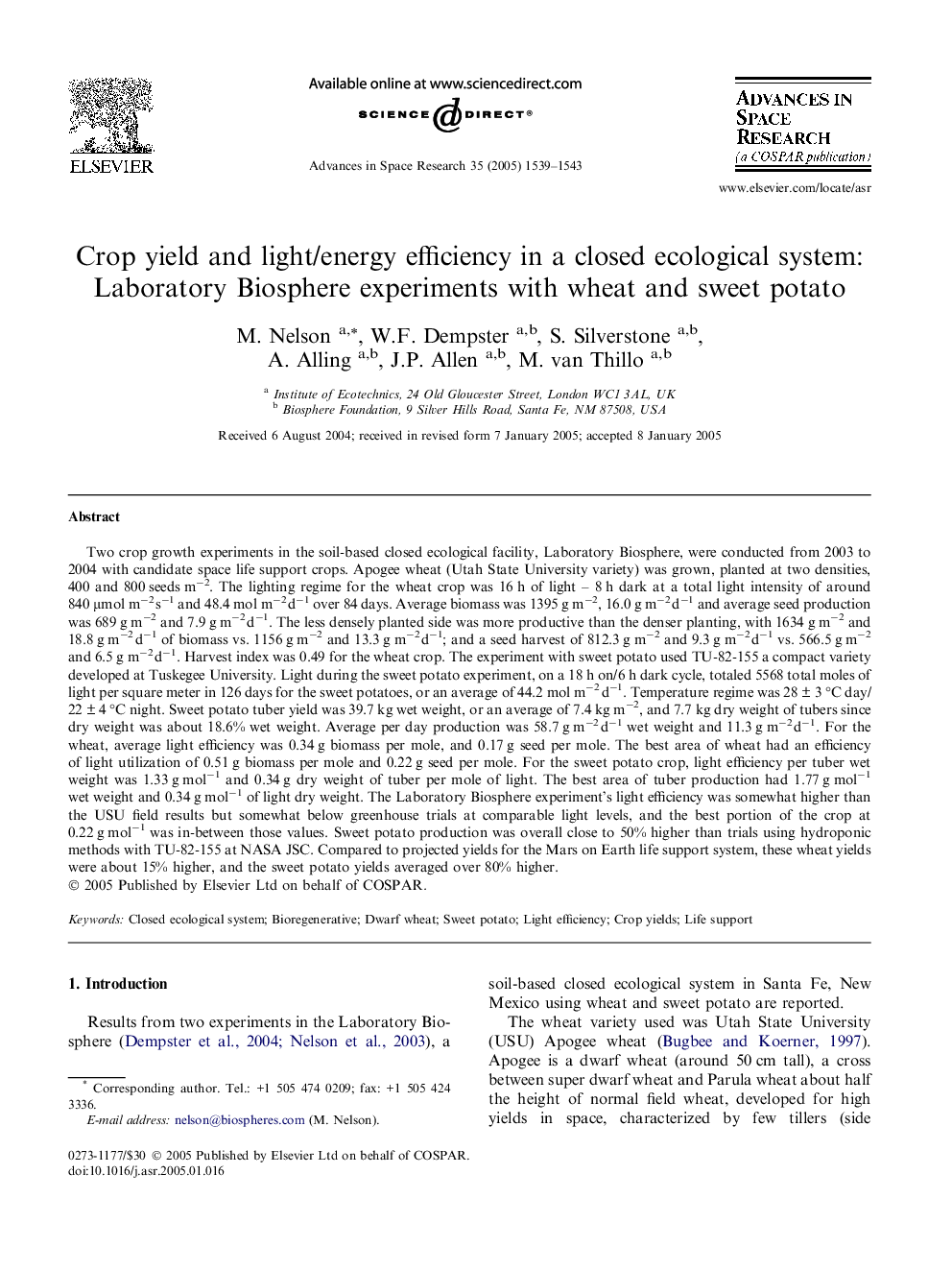| کد مقاله | کد نشریه | سال انتشار | مقاله انگلیسی | نسخه تمام متن |
|---|---|---|---|---|
| 10695402 | 1020274 | 2005 | 5 صفحه PDF | دانلود رایگان |
عنوان انگلیسی مقاله ISI
Crop yield and light/energy efficiency in a closed ecological system: Laboratory Biosphere experiments with wheat and sweet potato
دانلود مقاله + سفارش ترجمه
دانلود مقاله ISI انگلیسی
رایگان برای ایرانیان
کلمات کلیدی
موضوعات مرتبط
مهندسی و علوم پایه
علوم زمین و سیارات
علوم فضا و نجوم
پیش نمایش صفحه اول مقاله

چکیده انگلیسی
Two crop growth experiments in the soil-based closed ecological facility, Laboratory Biosphere, were conducted from 2003 to 2004 with candidate space life support crops. Apogee wheat (Utah State University variety) was grown, planted at two densities, 400 and 800 seeds mâ2. The lighting regime for the wheat crop was 16 h of light - 8 h dark at a total light intensity of around 840 μmol mâ2 sâ1 and 48.4 mol mâ2 dâ1 over 84 days. Average biomass was 1395 g mâ2, 16.0 g mâ2 dâ1 and average seed production was 689 g mâ2 and 7.9 g mâ2 dâ1. The less densely planted side was more productive than the denser planting, with 1634 g mâ2 and 18.8 g mâ2 dâ1 of biomass vs. 1156 g mâ2 and 13.3 g mâ2 dâ1; and a seed harvest of 812.3 g mâ2 and 9.3 g mâ2 dâ1 vs. 566.5 g mâ2 and 6.5 g mâ2 dâ1. Harvest index was 0.49 for the wheat crop. The experiment with sweet potato used TU-82-155 a compact variety developed at Tuskegee University. Light during the sweet potato experiment, on a 18 h on/6 h dark cycle, totaled 5568 total moles of light per square meter in 126 days for the sweet potatoes, or an average of 44.2 mol mâ2 dâ1. Temperature regime was 28 ± 3 °C day/22 ± 4 °C night. Sweet potato tuber yield was 39.7 kg wet weight, or an average of 7.4 kg mâ2, and 7.7 kg dry weight of tubers since dry weight was about 18.6% wet weight. Average per day production was 58.7 g mâ2 dâ1 wet weight and 11.3 g mâ2 dâ1. For the wheat, average light efficiency was 0.34 g biomass per mole, and 0.17 g seed per mole. The best area of wheat had an efficiency of light utilization of 0.51 g biomass per mole and 0.22 g seed per mole. For the sweet potato crop, light efficiency per tuber wet weight was 1.33 g molâ1 and 0.34 g dry weight of tuber per mole of light. The best area of tuber production had 1.77 g molâ1 wet weight and 0.34 g molâ1 of light dry weight. The Laboratory Biosphere experiment's light efficiency was somewhat higher than the USU field results but somewhat below greenhouse trials at comparable light levels, and the best portion of the crop at 0.22 g molâ1 was in-between those values. Sweet potato production was overall close to 50% higher than trials using hydroponic methods with TU-82-155 at NASA JSC. Compared to projected yields for the Mars on Earth life support system, these wheat yields were about 15% higher, and the sweet potato yields averaged over 80% higher.
ناشر
Database: Elsevier - ScienceDirect (ساینس دایرکت)
Journal: Advances in Space Research - Volume 35, Issue 9, 2005, Pages 1539-1543
Journal: Advances in Space Research - Volume 35, Issue 9, 2005, Pages 1539-1543
نویسندگان
M. Nelson, W.F. Dempster, S. Silverstone, A. Alling, J.P. Allen, M. van Thillo,